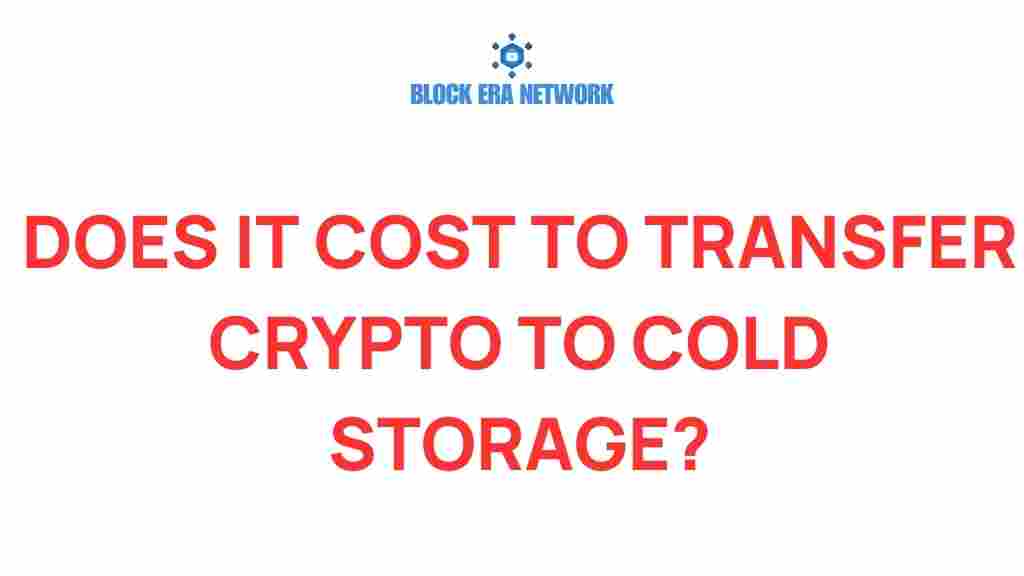Unveiling the True Cost of Transferring Crypto to Cold Storage: Understanding Crypto Transfer Costs
In the world of cryptocurrencies, the safety and security of your digital assets are paramount. As more investors and traders turn to cold storage solutions to protect their investments, understanding the costs associated with transferring crypto to cold storage becomes essential. This article aims to explore crypto transfer costs, the advantages of cold storage, and key strategies for ensuring cryptocurrency safety.
What is Cold Storage?
Cold storage refers to keeping digital assets offline, away from the reach of hackers and online threats. Unlike hot wallets, which are connected to the internet, cold storage solutions offer enhanced wallet security. Common forms of cold storage include:
- Hardware Wallets: Physical devices that store your private keys offline.
- Paper Wallets: A physical printout of your public and private keys.
- Air-gapped Devices: Computers or devices that have never been connected to the internet.
The Importance of Secure Storage
As the cryptocurrency market grows, so do the risks associated with it. The importance of secure storage cannot be overstated. Proper cold storage helps mitigate risks such as:
- Hacking: Keeping assets offline makes them less vulnerable to online attacks.
- Phishing: Cold storage solutions reduce exposure to phishing scams.
- Theft: Physical security measures can protect hardware wallets and paper wallets.
Understanding Crypto Transfer Costs
When transferring cryptocurrencies to cold storage, various factors contribute to crypto transfer costs. These include:
- Network Fees: Transaction fees paid to miners or validators for processing your transfer on the blockchain.
- Exchange Fees: If you are transferring from an exchange, there may be fees involved.
- Hardware Costs: Purchasing a hardware wallet incurs initial costs, which can vary widely.
Step-by-Step Process of Transferring Crypto to Cold Storage
Transferring your digital assets to cold storage is a straightforward process. Follow these steps to ensure a smooth transfer:
Step 1: Choose Your Cold Storage Solution
Decide whether you want to use a hardware wallet, a paper wallet, or an air-gapped device. Each option has its benefits:
- Hardware Wallet: User-friendly and secure.
- Paper Wallet: Cost-effective but requires careful handling.
- Air-gapped Device: Offers maximum security but can be more complex to set up.
Step 2: Purchase and Set Up Your Cold Storage
For hardware wallets, buy from reputable sources to avoid counterfeit devices. Follow the manufacturer’s instructions to set up your wallet securely, ensuring that you:
- Generate a secure seed phrase.
- Store your seed phrase in a safe place.
- Enable any security features available (e.g., PIN, biometric authentication).
Step 3: Prepare for the Transfer
Before transferring, ensure you have:
- Your cold storage wallet’s receiving address.
- Enough funds to cover crypto transfer costs.
Step 4: Initiate the Transfer
Log into your hot wallet or exchange account and follow these steps:
- Select the cryptocurrency you want to transfer.
- Enter your cold storage wallet address carefully.
- Review the transaction details, including the network fee.
- Confirm the transfer.
Step 5: Verify the Transfer
After initiating the transfer, use a block explorer to track the transaction. Ensure that the funds arrive in your cold storage wallet. This may take some time depending on network congestion.
Troubleshooting Tips for Crypto Transfers
While transferring cryptocurrencies to cold storage is usually seamless, issues can arise. Here are some tips to troubleshoot common problems:
Transaction Not Confirming
If your transaction is taking longer than expected, consider:
- Checking the current network fees and adjusting if necessary.
- Using a transaction accelerator service.
Incorrect Address Entry
If you suspect you entered the wrong address:
- Check your transaction history on the sending wallet.
- If funds were sent to the wrong address, retrieval is usually impossible.
Hardware Wallet Not Recognized
If your hardware wallet isn’t recognized:
- Ensure drivers are installed correctly.
- Try using a different USB port or cable.
- Restart your computer and wallet software.
Investment Strategies for Using Cold Storage
Investing in cryptocurrencies involves understanding not only the market but also your storage options. Here are some strategies to consider:
Diversification
Consider diversifying your digital assets across multiple cold storage solutions. This can enhance security and provide peace of mind.
Regular Security Audits
Periodically review your cold storage practices. Ensure your hardware wallets are updated and that your recovery phrases are stored securely.
Long-Term Holding
If you plan to hold your cryptocurrencies long-term, using cold storage is ideal. It minimizes risks associated with online threats and market volatility.
Conclusion
Transferring your cryptocurrencies to cold storage is a crucial step in safeguarding your digital assets. While crypto transfer costs may vary depending on network fees and storage solutions, the benefits of enhanced security are undeniable. By understanding the process, preparing appropriately, and employing effective investment strategies, you can significantly improve your cryptocurrency safety.
For more information on cryptocurrency investment strategies, check out our comprehensive guide. Additionally, for the latest updates on blockchain technology and market trends, visit CoinMarketCap.
This article is in the category Crypto Security and created by Block Era Network Team
